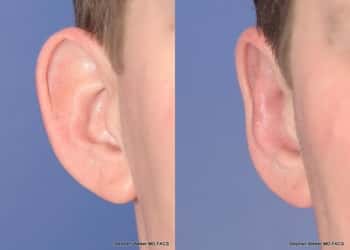Table of Contents
Otoplasty or ear repair is one of the most common cosmetic surgeries in the United States but is relatively unknown to the general public. Reducing the size of the humble earlobe is a rarely discussed, yet highly requested procedure. Because many children and adults feel self-conscious about the shape and size of their ears, otoplasty can have a huge impact on self-esteem. As a result, earlobe reduction has increasingly become a welcome solution for those who feel self-conscious about their ears. In fact, this procedure has been gaining in popularity even before Kardashian matriarch Kris Jenner famously underwent the procedure.
What is Earlobe Reduction?

Earlobe reduction is an office procedure that reduces large, sagging lobes that some people find aesthetically unappealing. Often the procedure is requested after years of consistently wearing heavy earrings that can stretch the lobes, as was the case with Kris Jenner. Occasionally, a large, pendulous ear can be a heredity feature. But in most situations, elongated earlobes are caused by the ageing process. As people age, earlobes gradually become longer because, unlike other body parts, lobes do not have cartilage. Due to a lack of structural support, they eventually succumb to the forces of gravity. There are many benefits to having earlobe reduction surgery, some of which include:
- The procedure is safe with negligible complications
- Provides symmetry to the facial appearance
- Increased self-confidence
- Extremely short recovery with minimal discomfort
- Minimal scarring
- Natural looking results
The earlobe may not be thought of as an aesthetic feature of the human face but it does impact the overall appearance. Making the lobe more propionate in size to the ear can provide a nuanced balance to facial features. That is why earlobe reduction has become a popular procedure and is generally performed for the following reasons:
- Drooping or floppy earlobes with hanging the skin
- Large, bulbous earlobes
- In conjunction with a facelift for a more youthful appearance
Earlobe Reduction Techniques: Wedge vs. Edge
There are many surgical techniques to reduce the size of the earlobe, but the two most frequently used are the wedge reduction method and the peripheral margin reduction technique, also known as the edge method.
Typically, the wedge technique is performed on patients who have an attached earlobe. This means there is no hanging skin below the ear and cheek junction so it requires a smaller amount of skin excision. The procedure is done by marking the earlobe with a geometric shape and placing a vertical incision along the earlobe. The excess earlobe tissue is removed and the incision is closed with stitches which will leave a small scar between the ear and cheek.
The edge technique is a more common procedure and is generally used for patients with detached earlobes. In this case, the lobes hang far below the junction of the cheek. This technique involves drawing a line around the globe to mark the preferred size and shape. The excess tissue is removed and the incisions are placed on the edge of the earlobe which will conceal the scar on the inferior border and the medial surface of the lobe.
Both the edge and wedge procedures are performed under local anaesthesia and generally take about thirty minutes to an hour to complete. Both procedures can be completed with a laser or a knife, however, the method chosen will depend on the size and shape of the lobe. Seasoned surgeons will ensure that there is symmetry between the left and right lobes. As with any surgical procedure, both earlobe reduction techniques require the surgeon to possess skill and artistry to achieve the desired aesthetic outcome.
Earlobe Reduction Recovery Process

Recovery from an earlobe reduction procedure is brief with a nominal degree of pain. There may be minimal swelling and bruising for a few days. Usually, the patient will be given an antibiotic ointment which should be applied for two weeks after the surgery to prevent infection. In addition, the doctor may recommend keeping the head elevated for three nights to minimize swelling. If needed, oral pain medication such as acetaminophen can be taken to address any discomfort.
Typically, patients can return to work the day after an earlobe reduction procedure but are advised to steer clear of strenuous activity such as heavy lifting for two weeks. A postoperative visit will take place 5 to 10 days after the surgery and at that time, sutures will be removed unless internal dissolvable stitches were used.
It is extremely unusual for complications to arise from an earlobe reduction procedure but some unlikely outcomes are overly reduced earlobes, earlobe asymmetry or pointed lobes, all of which would require a revision procedure to correct. Poor scarring can also occur but can be repaired with CO2 laser resurfacing.
Earlobe Reduction Consultation

The first step in the consultation process is deciding if an earlobe reduction will address the patient’s concerns. At this time, the doctor will examine the patient’s ears, discuss his or her expectations and develop a surgical plan to achieve the desired result. The doctor will also explain specific details regarding the ear reduction procedure as well as the postoperative process. It is important to choose a board-certified plastic surgeon with a proven track record in the field of otoplasty.
For more information about revision rhinoplasty, contact the owner and medical director of Weber Facial Plastic Surgery, Dr. Stephen Weber. Dr. Weber is a double board-certified facial plastic surgeon and is known for his deep understanding of facial aesthetics. His aptitude for facial plastic reconstructive surgery expanded while serving at the Oregon Health & Science University in a five-year Head and neck Surgery residency.
Dr. Weber’s practice focuses on cosmetic facial surgery and specializes in facial rejuvenation that includes face lifts, brow lifts, eyelid lifts and Otoplasty in Denver, CO.




